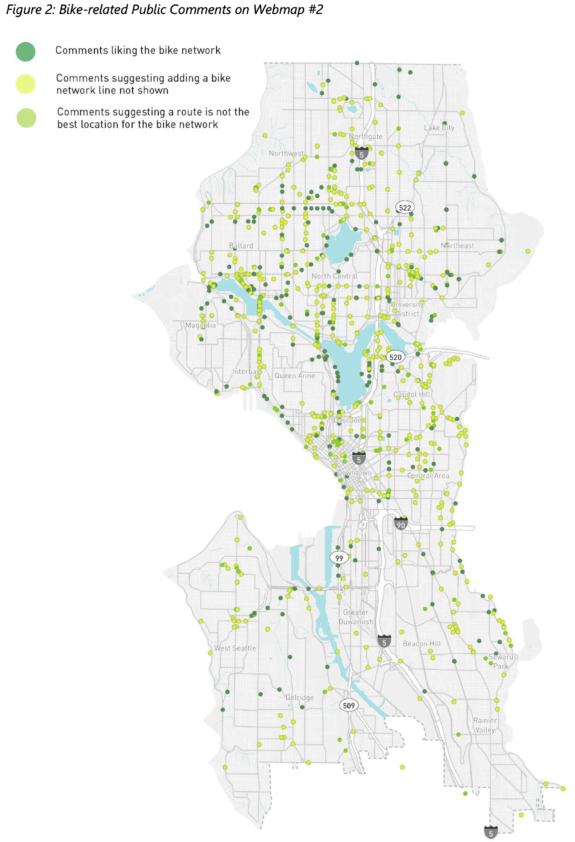Greenways: How to improve the Seattle Transportation Plan
 People have a lot of hopes for Seattle's bike network that were not featured in a previous draft. From the Draft Seattle Transportation Plan (PDF).
People have a lot of hopes for Seattle's bike network that were not featured in a previous draft. From the Draft Seattle Transportation Plan (PDF).The Seattle Transportation Plan will guide the next 20 years of local investments in our streets, so it's very important that we get this right.
Most immediately, the plan will form the basis for the transportation funding measure that Seattle will need to send to voters in 2024 to replace the expiring Move Seattle Levy. So this plan is not just a long-term plan, it will have a nearly immediate affect on what kind of work gets funding and by how much.
You will be asked to make a lot of comments on both this plan and the next funding measure over the next year, so buckle up. Every single step is very important and well worth your time. This is the biggest decision point for our city in the next decade. This is the time to not only talk about what kind of city we want to be and what outcomes we value most, but to put our funding where our mouths are.
Below is a list of suggested improvements for the plan that Seattle Neighborhood Greenways put together. They also include instructions on how you can support their ideas through the city's feedback hub or via SNG's advocacy alert form. From SNG:
Dear City Staff and Elected Leaders,
The 20 year transportation plan must be bold and transform every neighborhood into a great place to walk, bike, and roll!
The first draft plan fails to live up to that vision:
- It fails to include redesigns of our most dangerous streets like Aurora Ave, Rainier Ave S, Lake City Way, MLK Way S, and 4th Ave S. And it fails to lay out a credible pathway to reaching zero traffic fatalities and serious injuries by 2030 (Vision Zero).
- It fails to include any specific pedestrian-only streets - not even Pike Place Market.
- It fails to show how we will reach our climate goals to reduce emissions by doubling the number of people biking by 2030.
To make sure the plan effectively moves Seattlites in years to come and reduces emissions and traffic fatalities, SDOT needs to make the following improvements to the plan:
Three easy ways to Influence the STP Before Oct 23
- A clear vision: restore the previously included goal to have walking, rolling, biking, and transit be the most convenient way to get where you need to go, rather than just making it possible to walk, roll, or bike.
- Rapid progress: pick the rapid progress alternative that 95% of the public wanted and revise the plan to achieve it.
- Safety: Show a credible plan (like we proposed last year) for how the city will reach Vision Zero by 2030, including redesigning our most dangerous streets, and adopt a policy that all streets should only have at most one car lane in each direction (80% of people walking are run over on streets with more than one lane of traffic).
- Climate: Rapidly increase investments in bike, pedestrian, and transit networks to meet the city's ambitious goals so that by 2030, 7% of trips are by bike, 24% walking or rolling, 24% by transit, 10% in electric private cars, and 35% or fewer non-electric private cars. Require every project be designed so that it contributes to this goal. This must include a strategy to rapidly roll out a network of safe and convenient bike routes to where people need to go and pedestrianized streets or zones at the heart of every neighborhood.
- Equity: Meet Transportation Equity Framework commitments by 2028. Improve safety and prioritize investments in communities with histories of disinvestment. Do this work in tandem with strict anti-displacement measures, community engagement, and expanded affordable housing options on non-arterial streets.
- Accessibility: Make our city accessible for the 25% of residents that are nondrivers. Demonstrate that the city is complying with the ADA consent decree (and go further!)
- Accountability: Set specific, measurable, achievable, and timely goals to hold ourselves accountable to change.
- Process Reform: Too many projects get bogged down with seemingly endless processes that do not result in better outcomes. Community engagement for safety projects should be short and seek to understand and mitigate any real harms. Community engagement for projects that are primarily about creating community spaces should reflect community needs and desires.
- Get the details right: features like diverters, bollards, and concrete bike lane protection (not floppy plastic posts) should be standard to make our streets safer and more welcoming.
- Transparency: the public needs a second opportunity to comment on a new draft plan before it is finalized and sent to City Council.
- Send an email to the Seattle Department of Transportation.
- Use the comment box on the Seattle Transportation Plan Online Engagement Hub to tell SDOT Seattle should pursue rapid change. It should prioritize the movement of transit, cyclists, and pedestrians over cars to move faster towards a zero emissions and traffic safety collisions in Seattle."
- Forward this email [or blog post] to a friend. Word of mouth is a powerful form of advocacy.